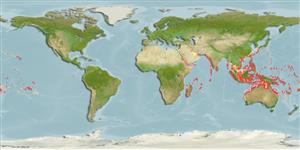Environment: milieu / climate zone / depth range / distribution range
البيئة
بحري; مياه مخلوطة مرتبطة بالشعاب; نطاق العمق 2 - 80 m (Ref. 1602). Tropical; 22°C - 27°C (Ref. 130614); 34°N - 34°S, 27°E - 124°W
Indo-Pacific: Red Sea to East Africa eastward through northern Australia reaching Tuamotu Islands, north to southern Japan.
الحجم / وزن / العمر
Maturity: Lm ? range ? - ? cm
Max length : 60.0 cm TL ذكر/ مختلط الجنس; (Ref. 9770)
الأشواك الظهرية (المجموع) : 3; الأشعة الظهرية الناعمة (المجموع) : 24 - 27; شوكة شرجية: 0; أشعه شرجية لينه: 22 - 25. Scales relatively large (Ref. 9002).
Inhabits coastal to inner reefs and estuaries, often in silty habitats (Ref. 48637). Found on lagoon slope and floor (Ref. 30573), also coral reefs. Generally solitary or in pairs (Ref. 4420). Young form small aggregations when common while adults are usually seen solitary, except when nesting and males congregate on certain sand flats adjacent to reefs (Ref. 48637). Feeds on tips of coral branches, gastropods, crustaceans, foraminiferans, and tunicates (Ref. 1602) and also on sea urchins (Ref. 9770). Oviparous (Ref. 205). Nest-guarding females are aggressive (Ref. 9770). Also caught with drive-in nets. Marketed fresh and dried-salted (Ref. 9770). Ciguatoxic in certain areas (Ref. 37816). Maximum depth reported taken from Ref. 128797.
Life cycle and mating behavior
النضج | التكاثر | وضع البيض | بيض | الخصوبة | Larvae
Males migrate to a traditional spawning ground where they establish territories enclosing nest sites and egg chambers (Ref. 9777). Nesting occurs in sand-bottomed channels and shallow cuts through the barrier reef (Ref. 9778, 37816). The nest consist of depressions up to 2 m wide and 0.7 m deep (Ref. 9778, 37816). Females arrive several days later and select a male for mating (Ref. 9777). Exhibit biparental care (Ref. 9777). Up to 430,000 or more eggs may be deposited in a spongy fist-sized cluster weighted down with pieces of rubble (Ref. 9778, 37816). Males establish a territory for spawning and parental care but not for feeding (Ref. 116451). Only females tend the eggs but both parents keep guard (Ref. 116451).
Myers, R.F., 1991. Micronesian reef fishes. Second Ed. Coral Graphics, Barrigada, Guam. 298 p. (Ref. 1602)
IUCN Red List Status (Ref. 130435: Version 2024-2)
خطر للأنسان
Reports of ciguatera poisoning (Ref. 1602)
استخدامات بشرية
مصائد: تجاري; حوض مائي: تجاري
أدوات
تقارير خاصة
Download XML
مصادر علي الأنترنت
Estimates based on models
Preferred temperature (Ref.
123201): 24.7 - 29, mean 27.8 °C (based on 976 cells).
Phylogenetic diversity index (Ref.
82804): PD
50 = 0.6250 [Uniqueness, from 0.5 = low to 2.0 = high].
Bayesian length-weight: a=0.02692 (0.01267 - 0.05719), b=2.92 (2.74 - 3.10), in cm total length, based on LWR estimates for this (Sub)family-body shape (Ref.
93245).
مستوى غذائي (Ref.
69278): 2.8 ±0.26 se; based on food items.
Generation time: 2.2 ( na - na) years. Estimated as median ln(3)/K based on 1
growth studies.
المرونه (Ref.
120179): عالي, الحد الزمني الأدني لتضاعف عدد أفراد المجتمع أقل من 15 شهر (K=0.49; Fec=430,000).
Fishing Vulnerability (Ref.
59153): Low to moderate vulnerability (29 of 100).
Nutrients (Ref.
124155): Calcium = 35.3 [15.1, 84.0] mg/100g; Iron = 0.604 [0.319, 1.321] mg/100g; Protein = 18.7 [16.6, 20.9] %; Omega3 = 0.11 [0.05, 0.22] g/100g; Selenium = 42.7 [20.7, 96.5] μg/100g; VitaminA = 26.4 [6.7, 99.7] μg/100g; Zinc = 1.13 [0.75, 1.74] mg/100g (wet weight);
